A very Vietnamese menu, which was uplifted by new exotic yet rural spices and delicate decoration, helped team 34 to subdue the jury to become the only representative of Vung Tau city in the final round.
Team
34 with 3 members, lead chef Pham Van Dai, Nguyen My Chuong, and Vu Kien Quyet,
from Palace Vung Tau had brought a curious-to-be menu, including: 1) Salad Thun
Mun leaves with avocado, crabmeat, and salmon caviar in hibiscus sauce; 2)
Shrimp and periwinkle kneaded with chili leaves, served with Chay fruit sauce;
3) Grilled fresh water eel fish with pagoda flowers and green peppers, served
with pagoda flower cake; 4) Stewed chicken and velvet with nutmeg and papaya
seeds, served with lotus seeds; 5) Cassava cake stuffed Thi fruits, served with
Gordon pineapple jam.
Chef
Pham Van Dai spent lots of his time researching to look for something that can
distinguish his team to others. Finally, he came up with the idea of using
normal healthy ingredients; those were too normal to be noticed. After winning
the 1st prize of Southeast preliminary, he flights to his hometown in Do Son
(Hai Phong province) to look for rural ingredients that had left deep
impression on his childhood.
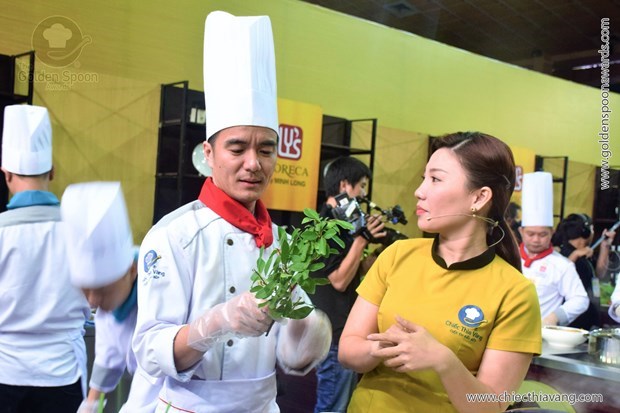
Chef Pham Van Dai excitedly introduced Thun Mun leaves.
He
had found Thun Mun (Embelia ribes Burn),
a wild tree that people had eaten its leaves to avoid dehydration. Chef Dai
said that Thun Mun leaves brought a fresh sourness to dishes, just a sour hint
to enrich the whole flavor. On the journey, the chef had come to
hundred-years-old Thi tree on Ngoc mountain for the fruits. After storms, the
old tree barely stood on the hill and the chef luckily collected its last
fruits. He had visited his friend in the North and had seen pagoda tree with
magical leaves, which were tea-like and so good with fish. He picked all those
spices and combined them with hibiscus leaves, dried Chay fruits (Artocarpus tonkinensis), and papaya
seeds.
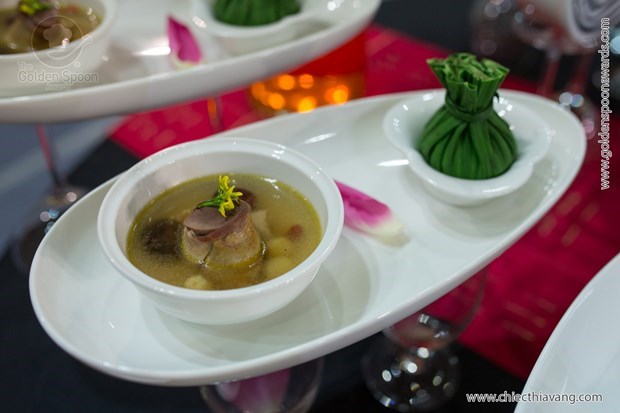
The golden dish: Stewed chicken and velvet with nutmeg and papaya seeds, served with lotus seeds.
Being
asked why using such a wasted ingredient as papaya seeds in the golden dish,
lead chef of team 34 answered, “Just by
accident. I saw my staff preparing papaya for breakfast. I tried a papaya seed,
which tastes like peppers. I made a trial, stuffing papaya seeds into chicken
and the result was good. Using a wasted thing to create new dish is an
interesting job.”
On
the date of semi-final round, the whole team arrived HCMC early to get packages
from the North - all hometown ingredients of chef Pham Van Dai. Their careful
preparation and teamwork had paid off.
The
appetizer included 2 dishes and both used wild leaves, Thun Mun and hibiscus,
which were appreciated by judges. The sourness stimulated appetite through the
meal. The chefs shared his tips that fresh saltwater crabmeat was vital, and
hibiscus sauce needed very-enough lime juice or the salad would be too sour.
The salad dressing included mayonnaise, hibiscus, white sugar, fish sauce,
olive oil, and lime juice.
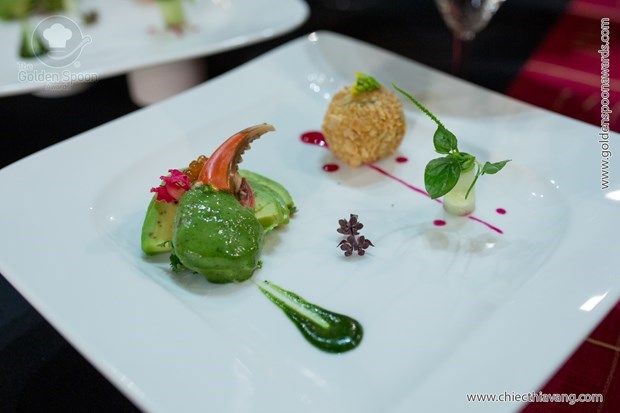
Appetizer has 2 dishes: Salad Thun Mun leaves with avocado, crabmeat, and salmon caviar in hibiscus sauce - Shrimp and periwinkle kneaded with pepper leaves, served with Chay fruit sauce and vegetables.
The
second dish of appetizer course was the combination of 2 healthy seafood,
shrimps and periwinkle, with chili leaves. The lead chef said that chili leaves
had a high oxidative level, which was good for diabetes patients, and to help
slowing down aging process. From the
idea of traditional sweet-rice cakes (banh chung, banh day), the dish was displayed
as a sphere to send a message that Vietnamese food would be brought around the
world.
The
key of this dish laid on the way chefs cleaned fresh shrimps by fresh coconut
juice. The seafood paste was chewy yet crunchy with featured aroma of chili and
almond. Chay fruit sauce was also a special aspect with its thick texture and
mildly sour taste well blended in a bed of spices, including pineapples, beets,
chili, lemongrass, cinnamon, cloves, and cardamom.
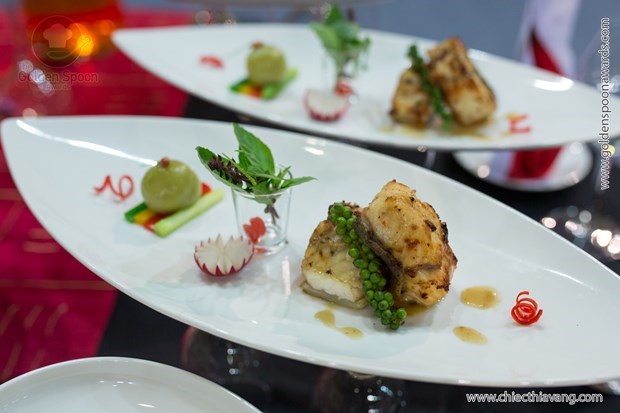
Grilled fresh water eel fish with pagoda flowers and green peppers, served with pagoda flower cakes and herbs.
Pagoda
flowers were such discovery in the dish. Those flowers have cooling effects on
human bodies so they need to stay with hot spices as peppers or chili to
balance out. Chefs chose big eel fish from flowing streams and cleaned it in
ginger rice wine to reduce its smell.

First time of pagoda flowers in The Golden Spoon contest.
Pagoda
flower cakes were not too complex to finish. Leaves and flowers were grinded
and filter to extract some juice. The juice was mixed in sweet rice flour with
a teaspoon of salt. Final dough was evenly divided and stuffed by cooked lotus
seeds. After 10 minutes boiling, the cakes were ready to serve.
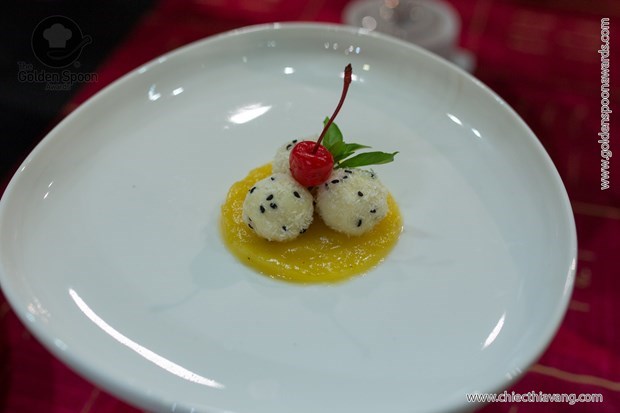
Cassava cake stuffed Thi fruit – Gordon pineapple jam.
Among
the treasure of Vietnamese fairy tales, Tam Cam is one of the most well known
stories with a detail of a Thi fruit. Being inspired by that mysterious tale,
the team was confident to bring Thi fruits into golden dishes. The combination
of Thi fruits’ fragrance, buttery cassava, and special sweetness of pineapple
jam absolutely persuaded the whole jury to give them the best comments.
Last
round, team 34 excellently had won the 1st prize of Southeast preliminary. Chef
Pham Van Dai brought his dreams come true when his passionate dishes had been
officially in the menu of Palace Vung Tau hotel. In July 2016, those new classy
dishes were honored to be in the menu of former Prime Minister Nguyen Tan Dung.
If you have a chance to stay at Palace Vung Tau, do remember to order “The
Golden Spoon dishes.”
Writer: Nguyen Trang
Translator: Thu Pham